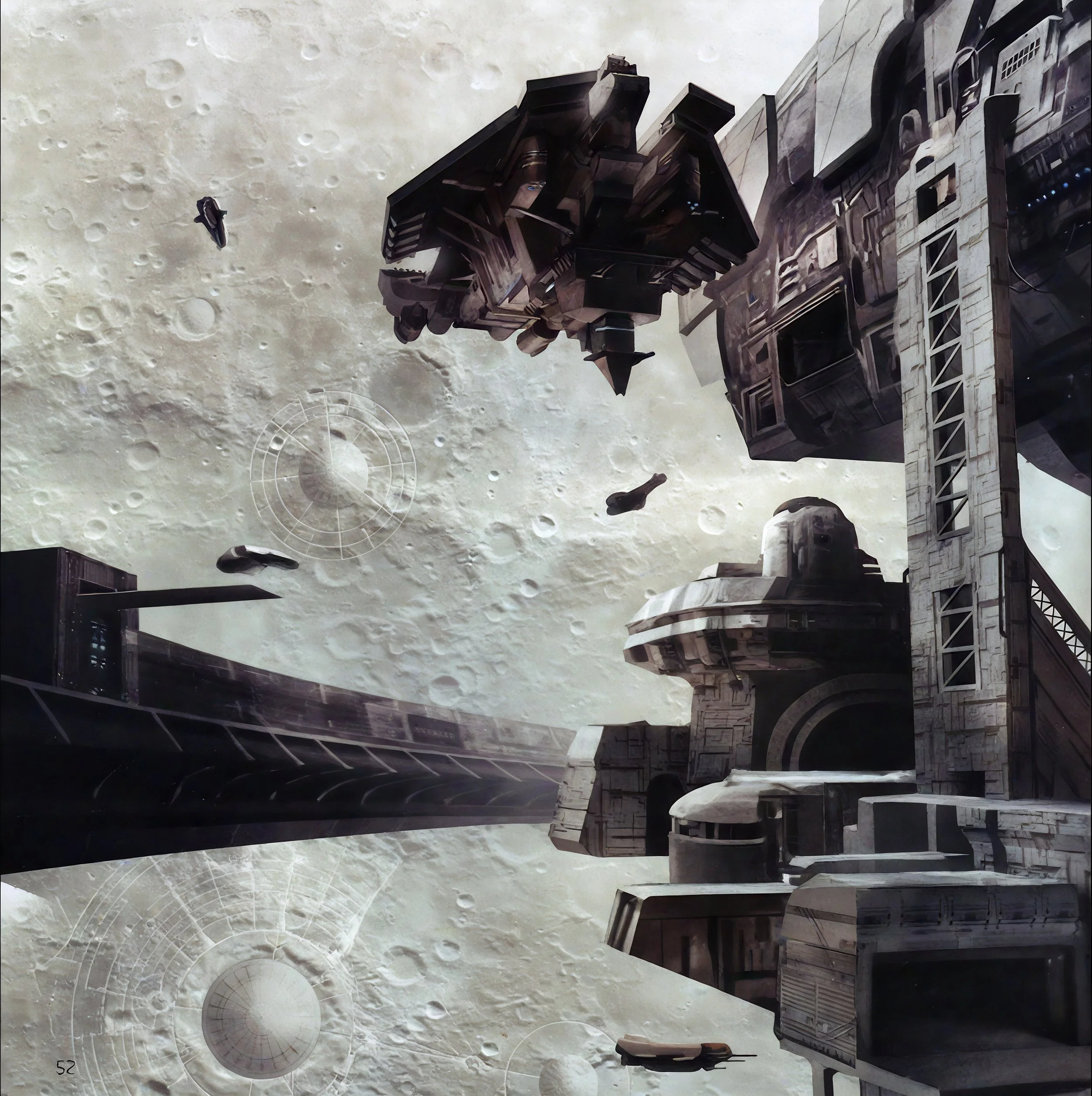 Important Events
Important Events
The Jovian Moons Campaign was a brief conflict in 2160 between the corporate-backed Friedens and the neo-communist Koslovics on several of the Jovian moons, spurred by a Frieden attack on a team of colonial advisers sent by the United Nations to help police the often violent region.
The Rainforest Wars was a large-scale conflict from 2162 to 2163 between the fascist Friedens, the neo-communist Koslovics, and the forces of the United Nations on the continent of South America.
The Mars Campaign was a retaliatory strike in December 2163 by the United Nations to eliminate the Koslovics, a rebel organizations labeled as terrorists by the UN.
The Interplanetary War was a six-year conflict between the United Nations, neo-communists known as the Koslovics, and the corporate-backed Friedens, an movement with strong fascist roots.
The Shaw-Fujikawa Translight Engine, informally known as an FTL drive or slipspace drive, was invented by a team of scientists led by Tobias Fleming Shaw and Wallace Fujikawa and unveiled to humanity in April 2291.
The first permutation of the Orion Project, the predecessor to the future Spartan programs in the 26th century, was initiated on April 13th, 2321, consisting of five test candidates.
The Domus Diaspora was a time period during humanity’s expansion into the galaxy that saw massive colonization efforts of hundreds of colony worlds in the span of around thirty years, starting in 2362.
The colony world of Arcadia, one of the many outer worlds to be colonized in the 25th century, was settled sometime in 2429.
The colony world of Meridian, a moon orbiting Hestia V in the Hestia system, was an outer colony world colonized sometime in 2431.
The outer colony world of Harvest, one of the youngest human colonies, was settled sometime in 2468.
 Important Events
Important Events
The Jovian Moons Campaign was a brief conflict in 2160 between the corporate-backed Friedens and the neo-communist Koslovics on several of the Jovian moons, spurred by a Frieden attack on a team of colonial advisers sent by the United Nations to help police the often violent region.
The Rainforest Wars was a large-scale conflict from 2162 to 2163 between the fascist Friedens, the neo-communist Koslovics, and the forces of the United Nations on the continent of South America.
The Mars Campaign was a retaliatory strike in December 2163 by the United Nations to eliminate the Koslovics, a rebel organizations labeled as terrorists by the UN.
The Interplanetary War was a six-year conflict between the United Nations, neo-communists known as the Koslovics, and the corporate-backed Friedens, an movement with strong fascist roots.
The Shaw-Fujikawa Translight Engine, informally known as an FTL drive or slipspace drive, was invented by a team of scientists led by Tobias Fleming Shaw and Wallace Fujikawa and unveiled to humanity in April 2291.
The first permutation of the Orion Project, the predecessor to the future Spartan programs in the 26th century, was initiated on April 13th, 2321, consisting of five test candidates.
The Domus Diaspora was a time period during humanity’s expansion into the galaxy that saw massive colonization efforts of hundreds of colony worlds in the span of around thirty years, starting in 2362.
The colony world of Arcadia, one of the many outer worlds to be colonized in the 25th century, was settled sometime in 2429.
The colony world of Meridian, a moon orbiting Hestia V in the Hestia system, was an outer colony world colonized sometime in 2431.
The outer colony world of Harvest, one of the youngest human colonies, was settled sometime in 2468.
 Evo-014's Summary 2160 - 2475 CE
Evo-014's Summary 2160 - 2475 CE
During the expansive era when humanity ventured beyond the boundaries of its home planet, Earth, and established a formidable presence on numerous worlds, a new chapter in history unfolded known as the colonial era. This transformative period was marked by unparalleled growth and progress, as humanity's reach extended far and wide across the cosmos.
Amidst this era of discovery and expansion, however, tensions and conflicts arose, giving birth to a tumultuous time known as the insurrection. The colonial era became a tapestry woven with both grand achievements and violent clashes, as disparate factions vied for power, resources, and differing visions for the future. It was a time of great societal upheaval and profound transformations, where the resilience of human spirit and the pursuit of independence clashed against the backdrop of vast interstellar landscapes. As colonies flourished and civilizations emerged on distant worlds, the challenges and struggles faced by humanity during this epoch shaped the course of history and laid the foundation for the battles yet to come.
The colonial era remains an integral part of our collective story, reminding us of the complexities, triumphs, and sacrifices that have shaped our interstellar civilization. Reflecting upon this era allows us to appreciate the resilience and determination of our ancestors as they navigated the uncharted territories of the cosmos.
 One Sun, Many Ideologies
One Sun, Many Ideologies
As the twenty-first century drew to a close, the indomitable spirit of humanity propelled us beyond the confines of Earth, establishing permanent colonies on various extraterrestrial bodies within the Sol system. Among these celestial realms were Luna, Mars, and several captivating moons orbiting the gas giant Jupiter known as the Jovian Moons.
Over the ensuing decades, these colonies flourished and grew exponentially, serving as fertile grounds for the sprouting of diverse ideologies distinct from those upheld by the United Nations governing Earth. By 2160, the ideological differences that had taken root within these extraterrestrial colonies erupted into a fierce and protracted conflict, unleashing a series of turbulent wars throughout the Sol system.
This era of turmoil culminated in the devastating Interplanetary War, a six-year-long conflict that reverberated across the cosmos. It was a time of immense sacrifice and unyielding determination as opposing factions clashed in a struggle for supremacy and control. Ultimately, the newly-formed United Nations Space Command emerged victorious, solidifying its dominion over all colonies within the Sol system.
The scars of this turbulent chapter in our shared history serve as a poignant reminder of the complexities and challenges faced by humanity as we ventured forth into the unknown. From the distant shores of Luna to the enigmatic landscapes of Mars and the captivating allure of the Jovian Moons, the interplay of divergent ideals and the fires of conflict shaped our journey through the stars.
The Jovian Moons Campaign was a brief conflict in 2160 between the corporate-backed Friedens and the neo-communist Koslovics on several of the Jovian moons, spurred by a Frieden attack on a team of colonial advisers sent by the United Nations to help police the often violent region.
The Rainforest Wars was a large-scale conflict from 2162 to 2163 between the fascist Friedens, the neo-communist Koslovics, and the forces of the United Nations on the continent of South America.
The Mars Campaign was a retaliatory strike in December 2163 by the United Nations to eliminate the Koslovics, a rebel organizations labeled as terrorists by the UN.
The Interplanetary War was a six-year conflict between the United Nations, neo-communists known as the Koslovics, and the corporate-backed Friedens, an movement with strong fascist roots.
 The Final Frontier
The Final Frontier
In the year 2291, two brilliant minds in the realm of theoretical physics, Tobias Fleming Shaw and Wallace Fujikawa, unveiled a monumental breakthrough: the awe-inspiring Shaw-Fujikawa Translight Engine. This groundbreaking invention marked a turning point, granting humanity the ability to traverse the vast expanse of space at speeds exceeding that of light itself.
With the advent of this remarkable technological marvel, the human race embarked on a grand odyssey, expanding their reach beyond the confines of their home star. The second half of the twenty-fourth century and a significant portion of the twenty-fifth witnessed an extraordinary surge in human colonization efforts, as countless pioneers ventured forth to settle distant worlds throughout the galaxy.
Between the years 2362 and 2475, humanity's relentless spirit led to the establishment of over eight hundred colonies across the cosmos. This momentous expansion not only broadened our horizons but also alleviated the strains of overpopulation on Earth and the Sol colonies.
However, this rapid proliferation of new colonies brought forth a renewed struggle between the central government of Earth and the colonists yearning for greater autonomy and freedom. The aspirations for self-governance sparked tensions and discontent among the inhabitants of these burgeoning settlements.
By the close of the twenty-fourth century, insurrectionist movements had taken root within many of the newly formed colonies. These uprisings instigated a wave of violence, tragically claiming the lives of over one million individuals as the galaxy stood on the precipice of change.
It was during this tumultuous period that humanity made its first contact with an enigmatic extraterrestrial force known as the Covenant in the year 2525. This encounter, shrouded in uncertainty, heralded the dawn of a new era fraught with both perils and possibilities.
The stage was set, the seeds of destiny sown, as the paths of humanity and the Covenant converged, forever altering the course of our shared galactic journey.
The Shaw-Fujikawa Translight Engine, informally known as an FTL drive or slipspace drive, was invented by a team of scientists led by Tobias Fleming Shaw and Wallace Fujikawa and unveiled to humanity in April 2291.
The first permutation of the Orion Project, the predecessor to the future Spartan programs in the 26th century, was initiated on April 13th, 2321, consisting of five test candidates.
The Domus Diaspora was a time period during humanity’s expansion into the galaxy that saw massive colonization efforts of hundreds of colony worlds in the span of around thirty years, starting in 2362.
The colony world of Arcadia, one of the many outer worlds to be colonized in the 25th century, was settled sometime in 2429.
The colony world of Meridian, a moon orbiting Hestia V in the Hestia system, was an outer colony world colonized sometime in 2431.
The outer colony world of Harvest, one of the youngest human colonies, was settled sometime in 2468.












